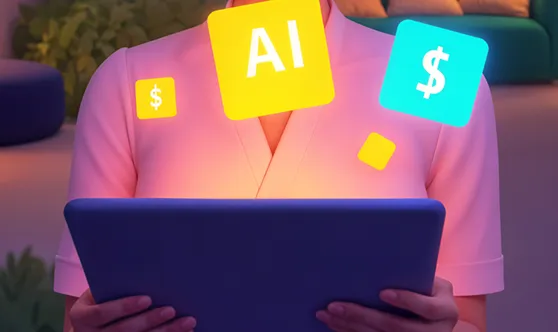
In analyzing over 2,000 website development projects, we've identified the most pressing AI website design questions that account for 85% of design challenges. This compilation addresses the critical areas where developers and designers often seek expert guidance, providing actionable insights to enhance the functionality, aesthetics, and user experience of AI-driven websites.
AI website design integrates artificial intelligence technologies into the web design process to create smarter, more personalized, and adaptive websites. Unlike traditional web design, which relies heavily on manual coding and predefined templates, AI design utilizes machine learning algorithms to analyze user behavior, automate design tasks, and optimize user experiences dynamically.
Real-World Example: Platforms like Wix and Bookmark use AI to generate website layouts based on user inputs, significantly reducing the time and effort required to build a site.
Actionable Solution: Start by incorporating AI design tools that offer template suggestions and automated content generation. Gradually integrate more sophisticated AI features like chatbots or personalized recommendation systems as your project evolves.
AI enhances website design by offering:
Common Misconception: AI can fully replace human designers. In reality, AI serves as a powerful tool that augments the designer's capabilities, allowing for more creative and efficient workflows.
Actionable Solution: Leverage AI to handle data-driven tasks and routine design processes, freeing up time for creative and strategic initiatives that require human intuition and creativity.
The most prevalent AI technologies in website design include:
Configuration Sample:
// Example: Integrating a simple machine learning model for content recommendation
import mlModel from 'ml-model-library';
const userData = getUserData();
const recommendations = mlModel.predict(userData);
updateContent(recommendations);
Actionable Solution: Identify which AI technology aligns with your website's goals. For example, use NLP for improving customer support through chatbots or machine learning for personalized content delivery.
AI-driven personalization analyzes user behavior and preferences to deliver customized content, recommendations, and interactions. This leads to:
Real-World Example: Netflix uses AI algorithms to suggest shows and movies based on individual viewing habits, significantly increasing user engagement and retention.
Actionable Solution: Implement AI tools that track user interactions and preferences. Use this data to dynamically adjust content, layout, and recommendations to better meet user needs.
Integrating machine learning models involves:
Code Example:
# Example: Training a simple recommendation model using Python
from sklearn.model_selection import train_test_split
from sklearn.ensemble import RandomForestClassifier
import pandas as pd
# Load and prepare data
data = pd.read_csv('user_behavior.csv')
X = data.drop('preferred_content', axis=1)
y = data['preferred_content']
# Split data
X_train, X_test, y_train, y_test = train_test_split(X, y, test_size=0.2)
# Train model
model = RandomForestClassifier()
model.fit(X_train, y_train)
# Evaluate
accuracy = model.score(X_test, y_test)
print(f"Model Accuracy: {accuracy * 100:.2f}%")
Actionable Solution: Start with pre-built machine learning models provided by AI design platforms. For custom needs, collaborate with data scientists to develop and integrate models tailored to your website's specific requirements.
Best practices include:
Common Pitfall: Overloading the website with too many AI features, leading to a cluttered and confusing user experience.
Actionable Solution: Prioritize AI features that provide the most value to your users. Implement them incrementally and gather user feedback to ensure they enhance the overall experience.
Common challenges include:
Data Quality and Quantity: Insufficient or poor-quality data can hinder AI effectiveness.
Integration Complexity: Integrating AI tools with existing systems can be technically challenging.
Cost: Advanced AI technologies can be expensive to implement and maintain.
User Privacy Concerns: Handling user data responsibly is crucial.
Troubleshooting Tip: When facing integration issues, consult the AI tool's documentation and support forums. Often, similar issues have been encountered and resolved by the community.
Monitoring and optimizing AI-driven features involves:
Actionable Solution: Set up a comprehensive monitoring system that tracks both technical performance and user experience metrics. Regularly review the data to identify trends and make informed optimization decisions.
Emerging AI technologies include:
Real-World Example: AI-driven AR tools allowing users to visualize products in their environment before making a purchase, enhancing the e-commerce experience.
Actionable Solution: Stay informed about the latest AI advancements and experiment with integrating new technologies that align with your website's goals and user expectations.
Designers can prepare by:
Actionable Solution: Invest time in learning basic AI concepts and tools relevant to web design. Build a multidisciplinary team that blends design expertise with AI knowledge to create innovative and effective solutions.
Integrating AI into website design offers unparalleled opportunities to create intelligent, adaptive, and highly personalized user experiences. By addressing common questions and challenges through expert-driven Q&A, this guide provides a solid foundation for leveraging AI technologies effectively in your web design projects. Embrace these insights to stay ahead in the evolving digital landscape and deliver websites that not only meet but exceed user expectations.




Subscribe to our newsletter to receive $100 off your first month of Tapflare's flat rate unlimited design and development service. Your coupon code will be sent to your email.